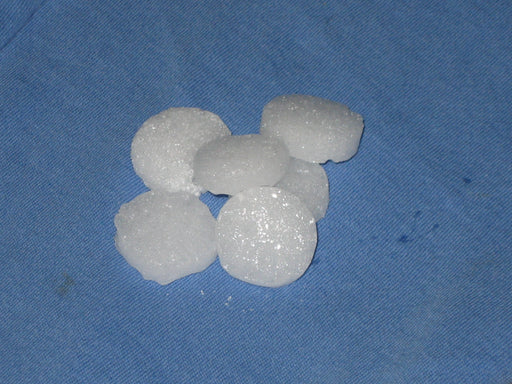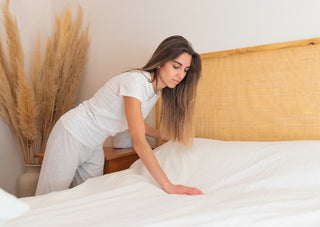Moth Balls - A Homeowners Guide
 Farmercarlos at en.wikipedia), Public domain, via Wikimedia Commons
Farmercarlos at en.wikipedia), Public domain, via Wikimedia Commons
Moth balls were a go-to choice for deterring moths from getting into the home and destroying clothing. However, if you’re considering purchasing old fashioned naphthalene moth balls, there’s cause for pause. There are many dangers associated with naphthalene moth balls, which is why many countries, such as the UK, Australia, New Zealand, and the whole of Europe have banned the sale of the chemical.
What are Moth Balls?
If you’ve never come across a moth ball before, at first you may be confused by these pungent white discs or spheres in a drawer or wardrobe. These balls are made out of pure chemical pesticides—either naphthalene or paradichlorobenzene.
Moth balls release a gas over time that deters adult moths from your clothes storage areas, as well as killing any moths, larvae and eggs in that area.
How to Use Moth Balls Correctly
The best answer is simply to avoid using chemical moth balls altogether. If you’re in a part of the world where they’re banned you’ll have no other option than to use a mothball alternative.
Most people don’t even realize that the use of moth balls is dangerous to their health.
That is why you should always wear gloves if you do decide to use these old fashioned moth balls, since the chemicals can cause a dermal reaction. Secondly, moth balls are most effective if they, and the clothes you are protecting, are placed in an airtight container along with them. This way the fumes will protect the clothing from moths while in storage.
Of course, moth balls can also be placed around clothes storage areas, closets and drawers and left for their vapours to dissipate.
Once you’re ready to take your clothing out of storage, bring the container outside and air out the clothes thoroughly - it can be tough to get rid of a mothball smell. Again, you might want to wear gloves and a face mask while handling the clothes. After a day or so of airing out the clothes, you must then wash them to remove the chemicals.
It’s a bunch of hard work to use mothballs - so avoid them!
Naphthalene Moth Balls – Are They Safe?
No! Naphthalene moth balls are not safe and we strongly recommend against purchasing or handling them when dealing with moth infestation.
That’s the big problem with moth balls—they contain dangerous chemicals that can make you and your family very ill. Naphthalene moth balls as their name suggests contain naphthalene, which is derived from petroleum or coal tar.
Individuals exposed to naphthalene vapours have experienced breathing difficulties, headaches, dizziness, nausea, and some may even develop hemolytic anemia. Furthermore, skin irritation is common. Children and pets are also vulnerable to naphthalene poisoning. Children with medical conditions may also develop kidney damage, anaemia, and jaundice. Moreover, the naphthalene moth balls are highly carcinogenic and flammable.
In short, the answer is no, naphthalene moth balls are not safe. This is why MothPrevention does not sell naphthalene moth balls, as we care about the safety of our customers and their families.
Alternatives to Old Fashioned Moth Balls
How do you deter moth larvae from eating natural fibres and woollen clothing if you can’t use moth balls? The good news is that there are plenty of alternatives to naphthalene moth balls out there. You can, for example, use natural deterrents, such as cedar blocks and chips, lavender sachets, or a sprinkle of rosemary, thyme, lemongrass, neem and cloves to keep moths at bay.
See our full guide to Moth Ball Alternatives by clicking right here.
These are just deterrents, however, and will not be effective with the removal of adult moths, larvae, and their eggs.
If you want complete protection, we recommend:
- MothPrevention® Clothes Moth Trap: Using pheromones to attract male Clothes Moths, these sticky traps prevent male moths from mating with females. Moth traps are also excellent for monitoring the extent of the moth population in your home.
- Clothes Moth Killer Kits: When your home has been invaded, you need to start fighting back against the moths, eggs, and larvae. MothPrevention has developed Moth Killer Kits that target each part of the moth life cycle, so you can get the infestation under control.
Say No to Moth Balls
Old fashioned naphthalene moth balls are not safe, nor are ones made out of paradichlorobenzene. Stay away from moth balls and choose non-toxic alternatives, such as lavender and cedar sprays, or pheromone Moth Traps from MothPrevention. The alternatives are safer and more effective at controlling moths.
FAQs
Do all moth balls have naphthalene?
No, not all moth balls have naphthalene in them. Another common ingredient added to moth balls is paradichlorobenzene, which is also a dangerous pesticide. It’s best to stay away from moth balls entirely.
Do moth balls have different levels of naphthalene?
No, moth balls in the US have high concentrations of either naphthalene or paradichlorobenzene—nearly 100% of the active ingredient. This means that all moth balls sold generally have the same amount of pesticides in them. There is no such thing as a safe amount of naphthalene.
Is smelling naphthalene balls harmful?
Yes, naphthalene is a very dangerous chemical that can cause dermal and respiratory distress in adults and children.
Why are moth balls banned?
In the US, old fashioned naphthalene moth balls are still sold. However, the EU EPA banned moth balls containing naphthalene in 2008. Australia and New Zealand have also banned moth balls. That said, using moth balls in any way other than described in the instructions is illegal in the US.
About MothPrevention
MothPrevention® speak to customers every day about their clothes moth issues - clothes moths are a species that are ever increasing and that can cause significant damage to clothes, carpets and other home textiles.
To date, we’ve helped over 150,000 customers deal with their moth problems. We have developed professional grade solutions including proprietary pheromones engineered in Germany to the highest production standards.





